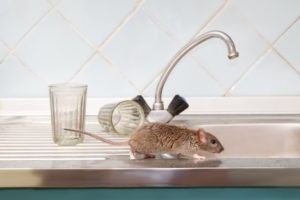
Rats are amazing adapters making rodent control difficult. Let’s explore and learn how to get rid of Norway Rats.
Know your enemy
The Norway rat has many names such as brown rat, wanderatte, sewer rat, wharf rat, water rat, and gray rat. Here are the key points:
- they are migratory
- head & body are 7-9.5 inches
- 7-18 ounces
- blunt snout
- small ears do not reach eyes
- brown with scattered black fur
- the tail is dark above and pale beneath
- droppings shaped like .75-1 inch capsule
- poor eyesight
- excellent smell, taste, touch, and hearing
- home range is 100 feet
Water
While Norway rats need water on a daily basis, stopping their water access can be impossible in certain situations. Surprisingly, they can obtain adequate water from certain foods they eat. Also, they are typically able to get enough water by licking it off of the condensation on pipes.
Food
Removing a Norway rat’s access to food is key. Food sources include:
- pet food
- food in cupboards
- food sealed in original packaging
- trash receptacles
- seeds
- bird feed dropped on the ground
- food on a neighboring property
Keep in mind that as higher quality food sources disappear, they will immediately move on to the next best thing. This can be key when trying to get them to take poison baits or baits in traps. Finding all of the food sources can be difficult especially considering they will make their own caches of food.
Shelter
Rats need a place to nest. Consequently, they may nest amidst clutter in a basement or garage or within voids of a wall. They may burrow underneath a woodpile or underneath a foundation slab. Therefore for structures, block off holes that are an inch or larger. These may be holes, separations, or just worn weather-stripping.
Trapping
Rats will frequent certain paths to and from the nest. Therefore, these paths can be identified by grease marks, urine spots, droppings, etc. Setting traps in frequently traveled areas will increase the likelihood of a successful trap. In addition, whatever type of trap you choose, ensure it is big enough and strong enough for the Norway rat. The trap should be specifically labeled for rats. It is best to place bait in the trap for several rounds before arming the trap. Rats are cautious and are likely to set off the trap while exploring it the first few times.
Poison baiting
In contrast to trapping, several baits are available for killing Norway rats including wax blocks, soft gels, and even liquids. If the bait isn’t working, focus first on eliminating other food sources before switching to a different bait. Above all, secure all baits in a tamper-resistant station to avoid negatively impacting non-target species. Place stations so the Norway rat can see the exit from the entrance.
Involve an Expert
Reach out to the rodent experts at Rove Pest Control to get advice along the way or help with any part of the process. If you don’t want to deal with the Norway rats at all, a Rove Pest Control expert can take the bulk of the process out of your hands. Learn more at roveboston.wpengine.com.
